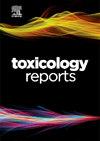IONPs-induced neurotoxicity via cascade of neuro-oxidative stress, parthanatos-mediated cell death, neuro-inflammation and neurodegenerative changes: Ameliorating effect of rosemary methanolic extract
Q1 Environmental Science
引用次数: 0
Abstract
Iron oxide nanoparticles (IONPs) are widely used in various fields, particularly in medicine, where they can be directly injected for diagnostic and therapeutic purposes, although they may induce certain types of toxicity. Therefore, the present work aimed to estimate the potential protective role of the oral extract of rosemary (RO)against the toxic effects of injected IONPs on the brain tissues of adult male rats, and to explore the potential underlying mechanisms involved in reversing such toxicity. Thirty adult male albino rats were allocated into five groups: the control, the vehicle (intravenous saline injection once/week), the RO extract group (orally gavaged100mg/kg/day), IONPs (intravenously injected 30 mg/kg once/week), and the combined RO+IONPs (orally gavaged RO extract 1 hrh before intravenous injection of IONPs). IONPs induced neurotoxicity via triggering a cascade of neuro-oxidative stress, neuro-inflammation, and parthanatos-mediated neuronal cell death by increasing MDA, NO, TNF-α levels, PARP-1, AIF, and NF-κB mRNA expression alongside reducing GSH levels. These incidents contributed to neurodegenerative changes, reflected in increased mRNA expression of α-S, β-APP, and TDP-43. Additionally, IONPs induced structural degenerative changes and elevated iron levels in brain tissues reduced occludin expression, and disrupted the BBB. Furthermore, the concurrent oral RO extract alleviated these conditions and repaired BBB by increasing the occludin expression and ameliorating structural changes in brain tissues. Consequently, the current data provide evidence that RO supplementation during IONP administration holds promise to minimize potential health risks, which should be corroborated by translational studies.
ionps通过神经氧化应激级联、parthanatos介导的细胞死亡、神经炎症和神经退行性改变诱导的神经毒性:迷迭香甲醇提取物的改善作用
氧化铁纳米颗粒(IONPs)广泛应用于各个领域,特别是在医学领域,尽管它们可能引起某些类型的毒性,但它们可以直接注射用于诊断和治疗目的。因此,本研究旨在评估迷迭香口服提取物(RO)对注射IONPs对成年雄性大鼠脑组织的潜在保护作用,并探讨其逆转这种毒性的潜在机制。将30只成年雄性白化大鼠分为5组:对照组、载药组(静脉注射生理盐水1次/周)、RO提取物组(口服100mg/kg/d)、IONPs组(静脉注射30 mg/kg 1次/周)、RO+IONPs联合组(静脉注射IONPs前口服RO提取物1 hrh)。IONPs通过增加MDA、NO、TNF-α水平、PARP-1、AIF和NF-κB mRNA表达,同时降低GSH水平,引发神经氧化应激、神经炎症和parthanatos介导的神经元细胞死亡,从而诱导神经毒性。这些事件导致神经退行性改变,反映在α-S、β-APP和TDP-43 mRNA表达增加。此外,IONPs诱导脑组织结构退行性改变和铁水平升高,降低occludin表达,破坏血脑屏障。此外,同时口服RO提取物可通过增加occludin表达和改善脑组织结构变化来缓解这些情况并修复血脑屏障。因此,目前的数据表明,在服用IONP期间补充RO有望将潜在的健康风险降至最低,这一点应该得到转化研究的证实。
本文章由计算机程序翻译,如有差异,请以英文原文为准。
求助全文
约1分钟内获得全文
求助全文
来源期刊

Toxicology Reports
Environmental Science-Health, Toxicology and Mutagenesis
CiteScore
7.60
自引率
0.00%
发文量
228
审稿时长
11 weeks
 求助内容:
求助内容: 应助结果提醒方式:
应助结果提醒方式:


